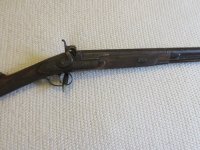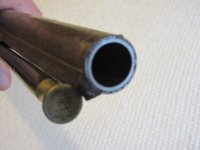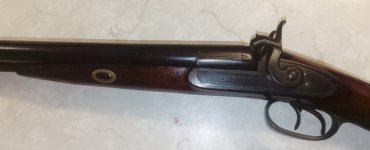Unless you get a modern reproduction muzzleloading shotgun, it is probable that any muzzleloading shotgun that you encounter will have barrels made with welded tubes. There were different ways of producing welded barrels. Simplest was a longitudinal linear seam. Essentially all military barrels were made this way, along with many lower priced barrels.
The preferred method was to wrap a spiral ribbon around a mandrel, welding the edges together to form a tube. The ribbon might be a simple strip of plain iron, perhaps 3/4" wide. Or the strip could be made up of small bars of iron and steel welded together edgewise. The little bars could be twisted then squared up again. This produced an attractive welded pattern when finished. Find member Pinfire's thread on British guns. You will see examples of the highest grade of British pattern welded barrels in those guns. Barrels of this pattern used ribbons made of three twisted rods welded together.
Two hundred odd years ago, the best British barrels were those made of "stubbs". They might be marked Stubbs Twist. These barrels were made from used horseshoe nails. It was considered that the "hammering of the horse's hooves on the hard hard highway" compacted the iron and made a better barrel. It might take 14 pounds of nails to make a 2 or 3 pound barrel. That much wrought iron might be oxidized away from the repeated heat cycles required to weld the nails into bars, strips and barrels.
There were many different patterns created in welding barrels. At the time, they had names. If you search Utube, you will find a video of Belgian barrel makers forge welding tubes. The epitome of pattern welded barrels were probably those made in Belgium which had letters and words worked into the iron/steel matrix. There are surviving barrels with legible letters - "REMINGTON, PRINCEALBERT, ZENOBEGRAMME".
"Cannons Damas la Fabrication" and an elaboration of this old film "How Damascus Barels Were Forged in 1925".
When the term "Damascus" is used nowadays, it probably refers to barrels showing a curled spiral twist. There are those who maintain that such barrels are bombs waiting to burst. The concern is that corrosion in the welds has produced weak spots which could fail. Certainly not impossible.
But once again - most any antique muzzleloading shotgun will have barrels made using tubes forge welded from strips. The higher the grade the gun is, the more complicated the weld pattern will be. If you are gong to shoot one, you will be shooting a "Damascus" barrel. Damascus barrels were popular into the 20th century on better grade guns. I have a Model 1894 Remington double with very attractive two stripe Damascus barrels.
This is a bit long, but it is a complicated subject. There is lots of information out there about pattern welded barrels.
The preferred method was to wrap a spiral ribbon around a mandrel, welding the edges together to form a tube. The ribbon might be a simple strip of plain iron, perhaps 3/4" wide. Or the strip could be made up of small bars of iron and steel welded together edgewise. The little bars could be twisted then squared up again. This produced an attractive welded pattern when finished. Find member Pinfire's thread on British guns. You will see examples of the highest grade of British pattern welded barrels in those guns. Barrels of this pattern used ribbons made of three twisted rods welded together.
Two hundred odd years ago, the best British barrels were those made of "stubbs". They might be marked Stubbs Twist. These barrels were made from used horseshoe nails. It was considered that the "hammering of the horse's hooves on the hard hard highway" compacted the iron and made a better barrel. It might take 14 pounds of nails to make a 2 or 3 pound barrel. That much wrought iron might be oxidized away from the repeated heat cycles required to weld the nails into bars, strips and barrels.
There were many different patterns created in welding barrels. At the time, they had names. If you search Utube, you will find a video of Belgian barrel makers forge welding tubes. The epitome of pattern welded barrels were probably those made in Belgium which had letters and words worked into the iron/steel matrix. There are surviving barrels with legible letters - "REMINGTON, PRINCEALBERT, ZENOBEGRAMME".
"Cannons Damas la Fabrication" and an elaboration of this old film "How Damascus Barels Were Forged in 1925".
When the term "Damascus" is used nowadays, it probably refers to barrels showing a curled spiral twist. There are those who maintain that such barrels are bombs waiting to burst. The concern is that corrosion in the welds has produced weak spots which could fail. Certainly not impossible.
But once again - most any antique muzzleloading shotgun will have barrels made using tubes forge welded from strips. The higher the grade the gun is, the more complicated the weld pattern will be. If you are gong to shoot one, you will be shooting a "Damascus" barrel. Damascus barrels were popular into the 20th century on better grade guns. I have a Model 1894 Remington double with very attractive two stripe Damascus barrels.
This is a bit long, but it is a complicated subject. There is lots of information out there about pattern welded barrels.
Last edited:










































































